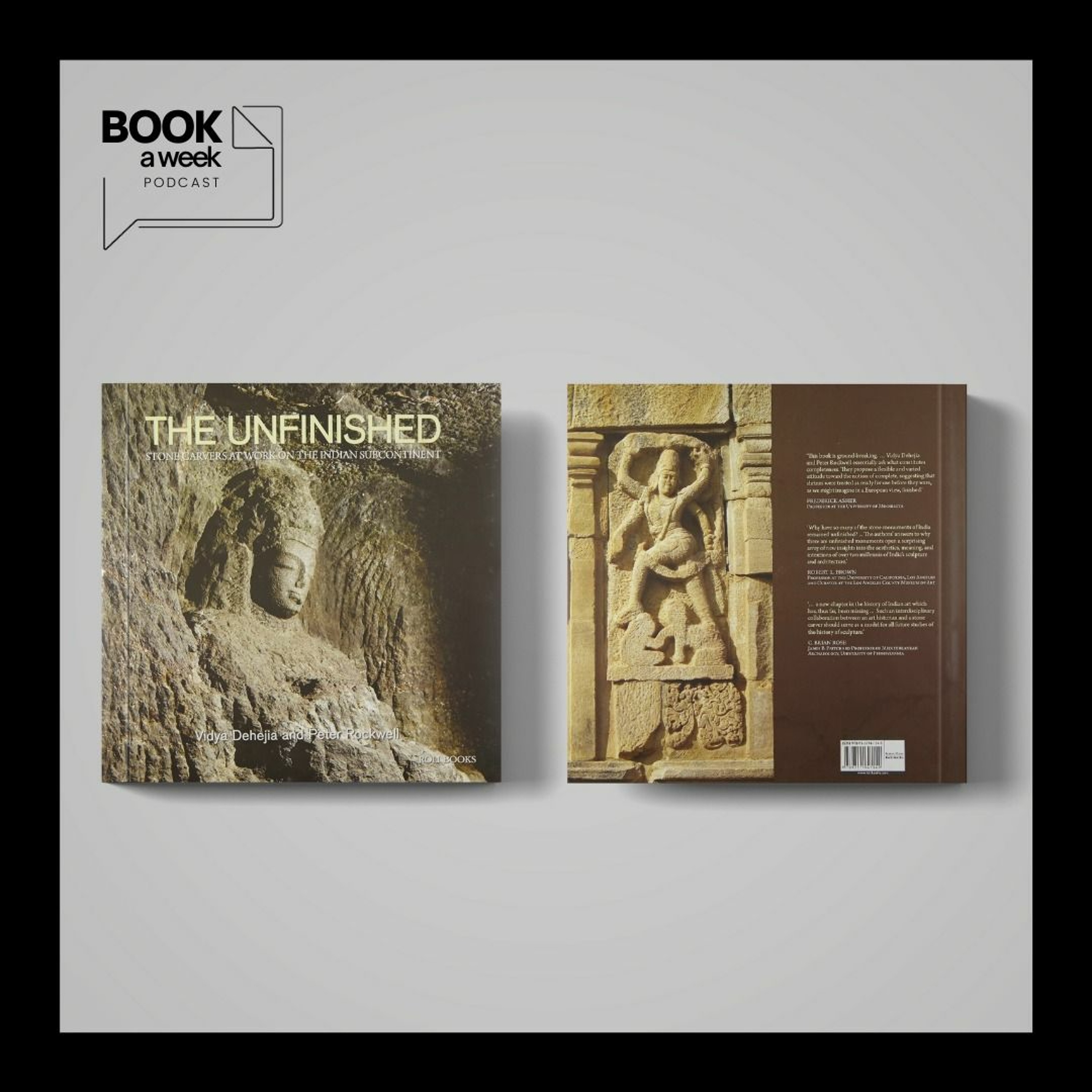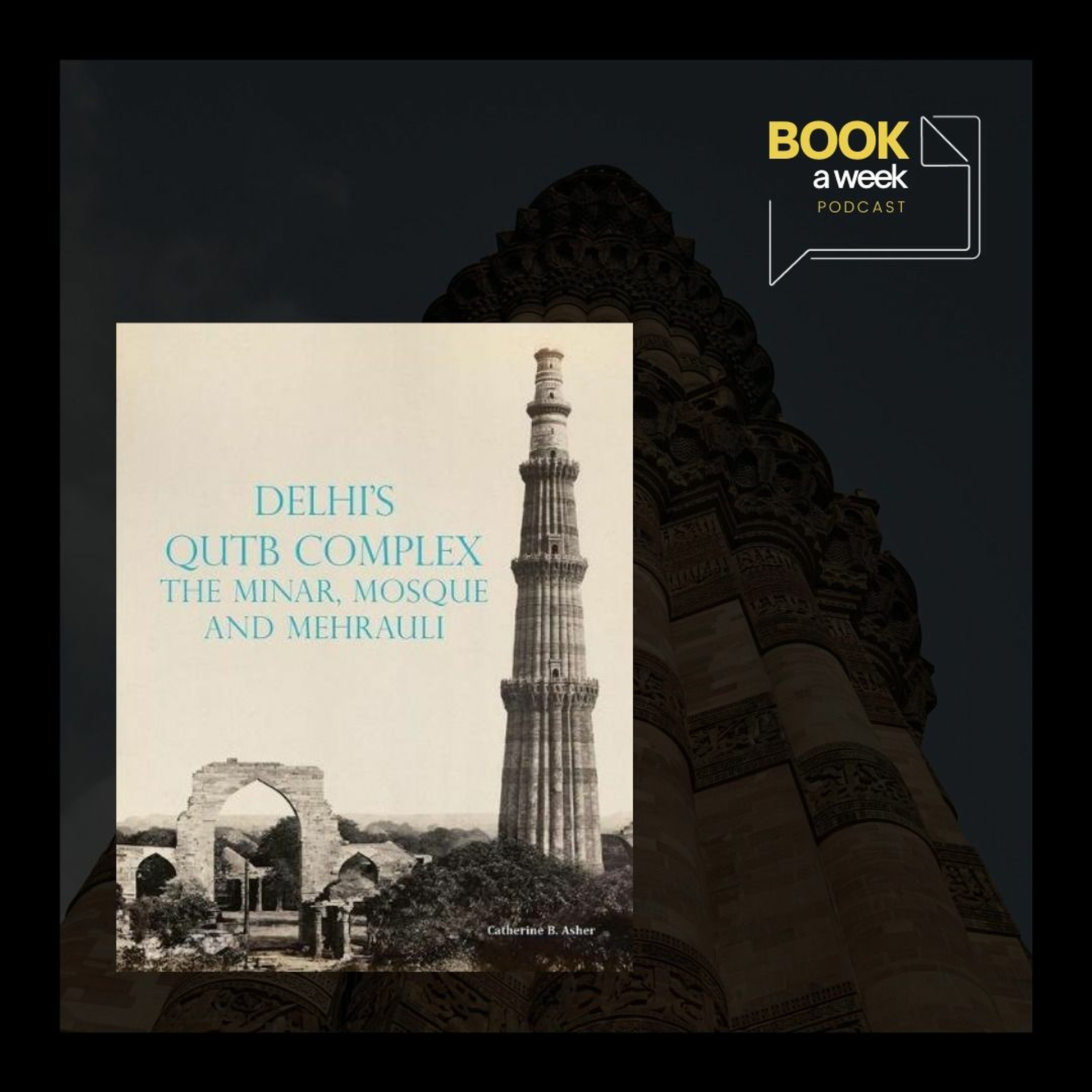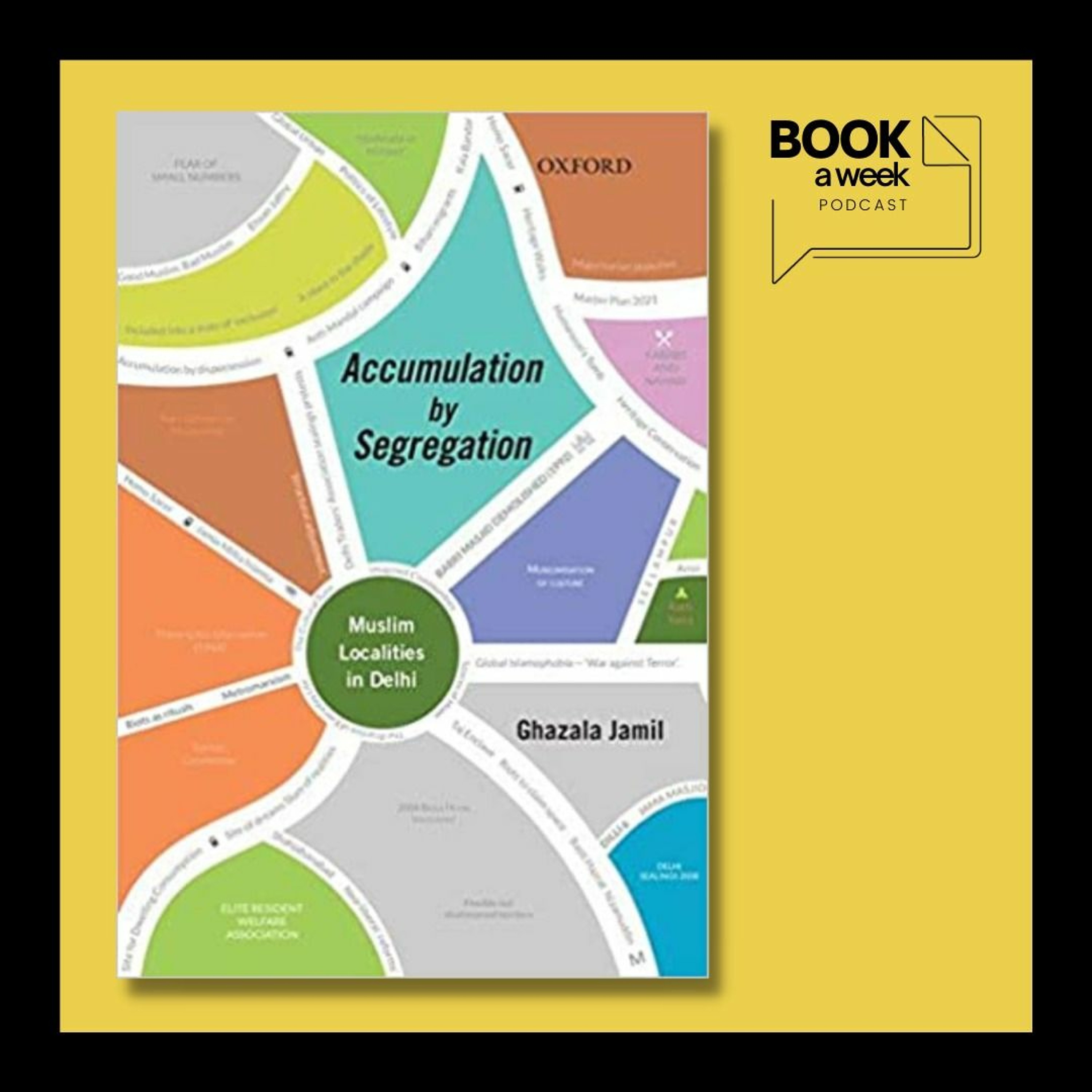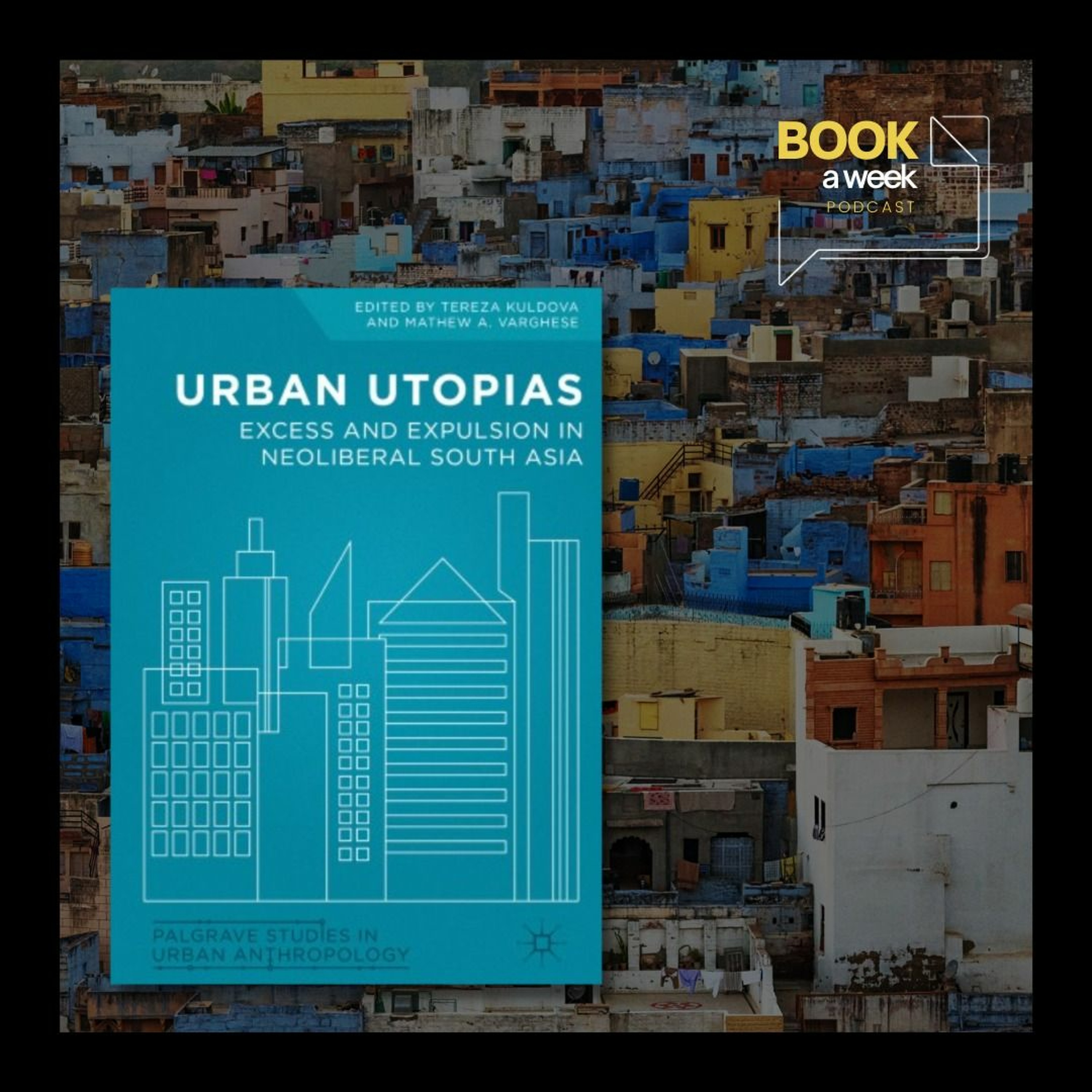Discover Book a Week
Book a Week

Book a Week
Author: CEPT Library & Center for Research on Architecture and Urbanism
Subscribed: 40Played: 285Subscribe
Share
© All rights reserved
Description
Book-a-Week is a weekly podcast in an author-interview format featuring new books on architecture and cities published in the last five years. Every week young scholars from the fields of architecture, urbanism and design research will interview authors of recent books on diverse topics from architectural history, design theory, and ecological thinking to urban studies and anthropology. Each episode is imagined as a reflective, genial conversation on the book, its context, significance and relevance in today’s time.
40 Episodes
Reverse
Bhavin Shukla engages in a discussion with Snehal Shah, Editor of ‘Footprints of Visvakarma: Studies in Indian Sculpture and Architecture' published by the Akshara Publications in 2018
Footprints of Visvakarma: Studies in Indian Sculpture and Architecture" is a scholarly exploration of Indian sculpture and architecture, delving into the rich heritage and artistic traditions of the region. Authored by M.A. Dhaky and edited by Snehal Shah, the book offers a comprehensive examination of the intricate details and profound symbolism found in Indian art forms, particularly focusing on the contributions of Visvakarma, the divine architect.
Madhusudan Amilal Dhaky (1927–2016) was a distinguished historian and researcher of ancient and medieval Indian art, architecture, and archaeology from Gujarat. Serving at the AIIS Varanasi Centre and later at the Lalbhai Dalpatbhai Institute of Indology, Ahmedabad, he was recognized for his extensive publications, including contributions to the Encyclopedia of Indian Temple Architecture. He received the Padma Bhushan in 2010 and a lifetime achievement award from the Gujarat Itihas Parishad.
Snehal Shah, an architect with a childhood passion for drawing, studied at CEPT, Ahmedabad, under renowned professors like BV Doshi and Anant Raje. Inspired by Minimalism and Japanese architecture, he founded EssTeam in 2013, known for modern design and community-focused projects. With a growing team, Shah emphasizes collaboration and empowerment in his pursuit of innovative architecture.
Shreyank Khemalapure engages in a discussion with Pinkish Shah, Editor of ‘Sen Kapadia Architect: In Pursuance of Meanings', published by the CEPT University Press in 2022
The book authored by Sen Kapadia, "In Pursuance of Meanings" is a profound reflection by esteemed architect Sen Kapadia, offering insights gleaned from over 50 years of professional practice. This seminal work, published by CEPT University, stands as a testament to Kapadia's view of architecture as a cultural endeavor. Written in the first person, the book is divided into four parts, each delving into different aspects of Kapadia's life and work. The book showcases eight carefully selected projects that exemplify Kapadia's design ethos and innovative approach. Overall, the book serves as a comprehensive compilation of Kapadia's life's work, providing a valuable resource for architects, scholars, and enthusiasts alike.
Sen kapadia is an Architect, Planner and Educationist, based in Mumbai. His illustrious career includes collaborating with renowned architect Louis Khan in establishing his own independent practice, a period that profoundly influenced his architectural journey. Beyond his architectural practice, Kapadia has made significant academic contributions through lectures, seminars, exhibitions, writings, and theoretical projects, enriching the discourse within the architectural community.
Pinkish Shah is an accomplished Design professional with a proven track record in the architecture and planning sector. With a Master's Degree in Architecture from The University of New Mexico, he brings a wealth of expertise to the table. He is also the founding Partner of the firm, S+PS Architects and former Dean Of Academic Affairs at Kamala Raheja Vidyanidhi Institute of Architecture
Bhavin Shukla engages in a discussion with Anjan Mitra about his book, ‘Durga Pujo and the City of Kolkata', which was published by the INDIANA & Sustained Actions for Value and Environment in 2022
The book written by Anjan Mitra delves into the concept of temporality and its connection to the Bengali tradition of Durga Pujo in Kolkata. It transcends the physicality of buildings to explore how cultural practices shape our perception of time and space. Drawing from over 20 years of research, Anjan Mitra the author underscores the collaborative nature of design, emphasizing that its impact is shaped through community engagement and negotiation.
Anjan Mitra has been involved with architecture and urban development as a researcher, a practitioner and an activist. Over three decades, he has engaged in numerous research projects, advocating for responsible design practices that prioritize the holistic experience of the built environment and its connection to society. Notably, his extensive involvement with the Durga Pujo festivities in Kolkata over two decades underscores his dedication to understanding and enhancing public spaces.Mitra recognizes design as a collaborative endeavor, emphasizing the importance of co-production and active negotiation to achieve meaningful impact.
Soumini Raja discusses the book ‘The Great Padma' with author Professor Kazi Khalid Ashraf. The Great Padma was published by the Goff Books in 2023
This book offers a comprehensive exploration of the intricate tapestry of life and history woven within the vast expanse of the Bengal Delta. The Book delves into the rich cultural heritage, geographical significance, and societal evolution of this unparalleled region. It offers a glimpse into the past and present of the delta, helping readers understand its importance and beauty in straightforward terms.
Kazi Khalid Ashraf is a Bangladeshi architect, urbanist and architectural historian. Working at the intersection of architecture, landscape and the city, Kazi Khalid Ashraf has authored various books and essays on architecture. Through his books and essays, he sheds light on architecture in Bangladesh and India, delves into the legacy of Louis Kahn, and examines the intricacies of Dhaka, the capital city. Ashraf's writings offer valuable insights into the evolution of architectural forms in Bangladesh, both in the past and present. Furthermore, his work on Dhaka presents the city as a focal point for understanding urban development within a deltaic setting, contributing significantly to urbanism discourse.
Shreyank Khemalapure engages in a discussion with Vasudhendra Shroff about his book, ‘The Unforgiving City and other stories', which was published by the Penguin Viking
in 2021
The book written by Vasundendra and translated by Mysore Nataraja, offers a raw and unflinching portrayal of urban life. Through a series of gripping narratives, it delves into the harsh realities faced by individuals navigating the complexities of modern cities. From the challenges of relationships to the pursuit of dreams amidst societal pressures, each story sheds light on the struggles and triumphs of urban existence. He captures the essence of the unforgiving cityscape, exploring themes of loneliness, resilience, and the search for meaning in a relentless urban environment.
Vasudhendra Shroff is an award-winning Kannada known for his short stories and novels. He is known for his writings that explore various aspects of urban life, including the experiences of the LGBTQ+ community in India. Through his exploration of themes like identity, relationships, and societal norms, Vasudhendra's work resonates with authenticity and depth. He is widely admired for his candid storytelling, which vividly portrays the complexities of contemporary Indian society, earning him accolades and praise from readers and critics alike.
Soumini Raja engages in a discussion with Lindsay Bremner about her book, ‘Monsoon as Method: A Book by Monsoon Assemblages', released by the Actar Publishers in 2022
The book written by Lindsay Bremner, Beth Cullen, Christina Leigh Geros, Harshavardhan Bhat, Anthony Powis and John Cook explores how the Monsoon Assemblages project engages with the monsoon as an active force in shaping urban life and space in South and Southeast Asian cities. It challenges the perception of climate as passive, highlighting its role in influencing urban politics, ecologies, infrastructures, buildings, and human bodies.
Lindsay Bremner is a South African scholar and architect, and is currently Professor of Architecture at the University of Westminster, in the United Kingdom. Renowned for her contributions to the field, Bremner has authored numerous acclaimed books and has been honoured with several awards, notably the Jane Jacobs Prize in 2011. Her research focuses on the intersection of oceans, design, and climate change, reflecting her commitment to addressing pressing environmental challenges through architectural innovation and scholarship.
Bhavin Shukla engages in a discussion with Prof. Miki Desai and Prof. Madhavi Desai about their book, 'Architecture and Independence: The Search for Identity – India 1880 to 1980', which was released in its second edition by the CEPT University Press in 2022.
The book written by Miki Desai, Madhavi Desai and Jon Lang explores how Indian architecture has evolved over the past century, reflecting the spirit of its times, particularly during the fight for Independence. It delves into how architectural styles and designs have changed in response to political shifts in India and globally since the establishment of the Indian National Congress.
Jon Lang is an emeritus professor at The University of South Wales where he headed the School of Architecture and taught in the Masters of Urban Development and Design Program (MUDD). He was director for urban design of ERG/Environmental Research Group Inc. in Philadelphia, Pennsylvania. He directed the joint MArch/MCP program in urban design there before settling in Australia. He has authored and co-authored numerous books on urban design, architectural theory and modern architecture in India.
Miki Desai retired as a professor from the Faculty of Architecture, CEPT University, Ahmedabad after teaching there from 1981 to 2014. He has authored and co-authored books and held national and international exhibitions, based on his extensive research as well as drawing and photo-documentation, especially from his study of the vernacular, colonial and modern architecture of India. His books include Wooden Architecture of Kerala (2008), Architecture and Independence: The Search for Identity: India 1880 to 1980 (co-authored with Jon Lang, Madhavi Desai, 2022) and numerous other notable works.
Madhavi Desai is an independent researcher, teacher and writer. She was an adjunct member of the Faculty of Architecture, CEPT University, Ahmedabad. She has authored, co-authored and edited several books on Indian architecture, especially with a focus on gender and built environment.
‘The Unfinished: Stone carvers at work in the Indian Subcontinent’ by Professor Vidya Dehejia and Peter Rockwell, is an exploration of the notions of ‘completeness’ in the context of construction of stone monuments of India. In this podcast, Venugopal Maddipati talks to Professor Dehejia about the varying degrees of unfinished stone monuments across the country to reveal the stories and the decisions that resulted in these incomplete works.
Vidya Dehejia is Barbara Stoler Miller Professor of Indian and South Asian Art at Columbia University and a Padma Bhushan awardee. Her extensive work in the field of art history draws from her travels across South Asia, and her background in classical Sanskrit and Tamil. Her subjects have ranged from Buddhist art in its earliest centuries to the esoteric temples of North India and from the sacred bronzes of the south to the art of British India.
Delhi’s Qutb Complex is one of the most iconic sites that has encountered several changes since its inception to the present day. Catherine Asher’s book ‘The Qutb Complex: The Minar, Mosque and Mehrauli’ traces these historical changes by analysing the site’s monuments, patrons, inscriptions, and history. In this conversation, Sunaina Shah talks to Catherine about the book and the modifications and appropriations that the Qutb complex site has undergone across several years of changing dynasties and political powers.
Catherine Asher is a specialist in Islamic and Indian art, well known for her work on the Mughal dynasty and the patronage of their Muslim and non-Muslim successors and predecessors. Her other interest is in the shrines that develop around deceased Sufi saints, and the appeal such complexes have for devotees. Her books include Architecture of Mughal India (2008), India before Europe (co-authored with Cynthia Talbot, 2006) and Perceptions of South Asia's Visual Past (1994).
Rajshree in conversation with Dr. Ghazala Jamil, on her book ‘Accumulation by Segregation: Muslim Localities in Delhi’, published by the Oxford University Press in 2017.
The book explores the processes of creation and articulation of social identities of Muslims in Delhi and spatial components of identification like residential segregation, interaction with public spaces and institutions; and the socio-political positionality of Muslims in the urban social fabric. It maps the landscape of discrimination in Delhi's neighbourhoods and analyzes how such fractured geographies are created.
Ghazala Jamil is an Assistant Professor at the Centre for the Study of Law and Governance, Jawaharlal Nehru University, New Delhi. She has earlier taught at the Department of Social Work, University of Delhi, and School of Planning and Architecture, New Delhi. Her current research interests are around materiality and spatiality of culture, urbanism, minority rights, and subaltern feminism.
Sunaina Shah talks to Ebba Koch on the book titled ‘The Mughal Empire from Jahangir to Shah Jahan: Art, Architecture, Politics, Law and Literature’. The book is edited by Ebba in collaboration with Ali Anooshahr and published in 2019. It is a collective volume of articles written by 14 eminent scholars, and it takes a multidisciplinary approach to bring together historical, literary, architectural, and social studies in order to form a more nuanced multidisciplinary understanding of the least studied period of the Mughal empire in India.
Dr. Ebba Koch is a leading scholar and an authority on architecture, art and court culture of the Mughals of South Asia and their connections to Central Asia, Iran and Europe. She has published extensively on the subject, and has taught at the Universities of Vienna, Oxford and Harvard.
Arul Paul talks to Dr. Rahela Khorakiwala, author of the book From the Colonial to the Contemporary: Images, Iconography, Memories, and Performances of Law in India's High Courts. In this book, Dr. Rahela traces the remnants of the colonial pasts apparent in the practice and performance of law in the high courts of India at Calcutta, Bombay and Madras. She argues that the iconographic identity of these courts helps preserve these historical notions of justice as evidenced in the contemporary perceptions of the court personnel.
Dr. Rahela Khorakiwala completed her MPhil/ PhD from Jawaharlal Nehru University in Delhi, and has, in the past, worked with the World Bank for a project in Kabul, the Ministry of External Affairs on an international maritime dispute, and the law offices of Federal & Company in Mumbai. Presently, she is a Senior Resident Fellow at Vidhi and leads the work for Vidhi Maharashtra. Dr. Rahela has several publications to her credit, including contributions to the Indian Law Review and the Asian Journal of Law and Society.
Sunaina Shah talks to Ray Meekar, author and photographer of the book Building with Fire, published by the CEPT University Press. The book is a compilation of Meeker’s best studio ceramics, with some essays that accompanied his show catalogs. The title ‘Building with Fire,’ is meant to underline a technique where fire is introduced into the construction processes as ‘cement’, for bonding building elements together permanently.
Born in New York, Ray Meeker lives and works in Puducherry, India where he founded Golden Bridge Pottery (GBP) with Deborah Smith in 1971. Pottery has remained significant in Meeker’s prolific practice which ranges from modest utilitarian ceramics to monumental sculptural installations and kiln buildings/homes, a result of a fourteen-year experiment in developing fire stabilized mud buildings.
Arul Paul talks to Tereza Kuldova and Mathew A. Varghese, editors of the book Urban Utopias: Excess and Expulsion in Neoliberal South Asia (Palgrave Studies in Urban Anthropology). The book brings together anthropologists and critical theorists to study utopian ideas of the future in India and Sri Lanka's neoliberal cities. The authors examine urban construction projects, special economic zones, fashion ramps, films, archaeological excavations, and queer spaces to argue for the importance of materiality to critique contemporary ideology.
Tereza Østbø Kuldova is a social anthropologist and Research Professor based at the Work Research Institute, Oslo Metropolitan University. She is the author of several books and edited volumes and is also the founder and editor in chief of the Journal of Extreme Anthropology.
Mathew A. Varghese is an Assistant Professor in the School of International Relations and Politics. He also serves on the editorial board of the Journal of Extreme Anthropology published from University of Oslo. He currently engages in inquiries into unintentional design and co-species evolutions of the Anthropocene.
Rajshree talks to Rahul Mehrotra about his latest book ‘Working in Mumbai, RMA Architects’ published this year in 2021, by the CEPT University Press. The book is a critical reflection on thirty years of practice of RMA Architects and is structured into five segments, each referring to projects that address questions generated by the complexity of the design program, and also its context. Through this book, Rahul Mehrotra weaves a narrative to connect his various involvement in architectural practise since 1990, including teaching, research, documenting, writing, and exhibiting.
Rahul Mehrotra is the principal founder of RMA architects, based in Mumbai and Boston. He is the Chair of Department of Urban Planning and Design and John T. Dunlop Professor in Housing and Urbanization at the Harvard Graduate School of Design. He has written and lectured extensively on issues concerning architecture, conservation, urban planning and design in Mumbai and in India.
Venugopal talks to Asher Ghertner about his book ‘Rule by Aesthetics’. The book talks about the role the state plays in everyday lives of the poor and how urban aesthetics often supersedes inclusivity in the Indian city. Asher contrasts the powerful influence in Delhi of property owning citizens as represented through the Resident Welfare Associations (RWAs) with the travails of the property less in the city, and their displacement from public land.
Dr. Asher Ghertner is an interdisciplinary scholar who uses the contemporary politics of slum demolition and urban renewal in India to challenge conventional theories of economic transition, city planning and political rule. He previously taught at the London School of Economics and is currently an Assistant Professor in Geography and Director of the South Asian Studies Program at Rutgers University. He is the author and editor of three books and has written widely on subaltern urbanism, environmental politics, aesthetic governmentality, property, and the uses and limits of gentrification theory.
Arul Paul talks to Anshuman Gupta on his book ‘Celebrating Public Spaces in India’ co-authored with Archana Gupta. The book explores the architectural identity and socio-cultural-functional strength of urban public spaces by analysing fifty vibrant landmarks from across the country.
Anshuman Gupta, co-founder of The Foundation of the Indian Cities, works as Vice-President, Head of Projects (South Asia), at Deutsche Bank AG. As an architect and an accomplished corporate real estate professional, he has travelled and worked across India. He is a strong proponent of the sustainable approach to design, and he spares time to research and write about urbanization and cities.
Sunaina Shah talks to George Michelle on his book ‘Late Temple Architecture of India, 15th to 19th Centuries’. This book is the first wide-ranging overview of temple architecture in the 500-year period that overlaps with the authority of the Sultanates, the Mughals, and the British and has been largely excluded from scholarly pursuit.
George Michell is Professorial Fellow at the School of Architecture, Building and Planning, University of Melbourne. He is a leading scholar on art and architecture in South Asia. His research has mainly concentrated on the Deccan, Bengal, Gujarat and, most recently, southern India. The projects have varied from surveys of town planning and Islamic buildings to detailed studies of temple architecture and sculpture. He is also a lecturer at universities and museums throughout the USA, Europe, India, and Australia.
Rajshree Rajmohan talks to Anindita Datta on her book "Gender, Space and Agency in India.’ This edited volume is a set of eleven insightful chapters by eminent researchers, each exploring links between gender space and agency across a diverse geographical context in India. The narratives are based on field studies and highlight not just the power of space in scripting gender, but also reinforced gendered spaces of power in a society marked by deep seated social divisions.
Anindita Datta is an Associate Professor at the Department of Geography, Delhi School of Economics. With over 20 years of teaching experience, she has published consistently in international peer-reviewed journals with interdisciplinary perspectives; served as a member on the international editorial boards for Gender, Place and Culture and Social and Cultural Geography; and is also a member of the Steering Committee, International Geographical Union (IGU) Commission on Gender and Geography.
Venugopal Maddipati talks to Hakim Sameer Hamdani on his book “The Syncretic Traditions of Islamic Religious Architecture of Kashmir”. The book presents the rich historical context of Islam in Kashmir and explores newer dimensions of tracing histories through architecture.
Hakim Sameer Hamdani is a notable architectural historian and an Islamicist and the Design Director of Indian National Trust for Art and Cultural Heritage (INTACH), Kashmir Chapter, Srinagar. Some of his major conservation projects include Reconstruction of 18th-century Wooden Shrine of Peer Dastgeer Saheb (2020–12) and Conservation of Aali Masjid at Eidgah, Srinagar (2007) ― both of which were longlisted for the Aga Khan Award for Architecture. More recently he has received an offer under the Agha Khan Program, to do his post-doctorate at MIT, where he will be carrying forward his work on Muslim architecture and Muslim identity in the late 19th and early 20th century Kashmir, in the background of colonialism and the freedom struggle.
























